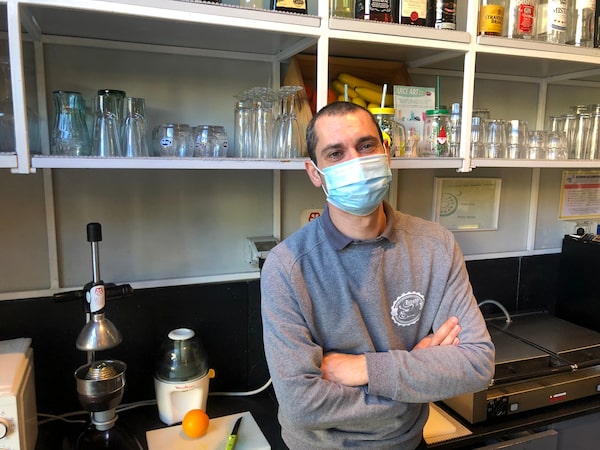
Michael Forciniti, owner of the small Ristretto 35 bistrot-café, in central Rome.The Globe and Mail
Millions of Italians returned to work on Monday with a mixture of relief and fear. Italy’s lockdown was finally easing off, but employees and business owners were worried that a second wave of coronavirus infections could send them back home.
Michael Forciniti, 36, owner of the small Ristretto 35 bistrot-café in central Rome, near the Circus Maximus, was making his first cappuccinos early on Monday for customers he had not seen since Italy went into quarantine on March 9. The coffees were for take-away only; he was passing the paper cups through a window facing the street.
He said his happiness at being back at work was hindered by financial anxiety. “I’m very demoralized,” he said. “The state gave me €600 in March but I have not seen one euro since then.”
Mr. Forciniti has one child and his wife is pregnant. The rent on the bar property is more than €1,500 (approximately $2,300) a month and he is not sure his business will survive. “Most of my business comes from office workers and if they are smartworking [working from home], they will not come,” he said.
In normal times, his café thrives because it is located only few metres from the United Nations Food and Agriculture (FAO) building, which houses 3,500 employees. FAO is reopening this week, but only about 40 employees will be allowed in the building at first, on a rotating basis, and no more than 500 are expected by September. “If the contagion comes back, we’ll be back in lockdown,” he said. “They’ll close everything again.”
Italy’s lockdown has been the world’s longest and caution is still the dominant theme, for fear of a second wave of COVID-19 infection, which some epidemiologists think is inevitable as the restrictions in Italy and other European countries are lifted. Italy, like all the countries forced into lockdown, is trying to strike a balance between protecting the economy, which is already in deep recession, and protecting public health.
On Sunday, Prime Minister Giuseppe Conte urged Italians to be careful and to respect physical distancing. “Like never before, the future of the country will be in our hands,” he said on his Facebook page. “We will need even more collaboration, civic sense and respect for everyone. … The more scrupulous we are observing the safety rules, the more we can regain our freedom.”
Monday’s new liberties marked only a partial lifting of the Italian lockdown, which was designed to contain the COVID-19 outbreak in northern Italy, where it hit in February to devastating effect. By Sunday night, Italy had recorded almost 29,000 coronavirus fatalities, the second highest in the world, after the United States, and almost 211,000 infections, of which 100,000 were current active cases.
Domenico di Massa and Mariantonia Gangemi embrace their granddaughter Cecilia for the first time in two months as Italy begins a staged end to a nationwide lockdown to curb the spread of the novel coronavirus, in Rome, on May 4, 2020.YARA NARDI/Reuters
The Italian pandemic peaked in late March and the number of fatalities, new infections and patients in intensive care have fallen steadily. On Sunday, 174 fatalities were recorded, down from the March daily peak of almost 1,000. The northern Italian region of Lombardy, the capital oh which is Milan, remains the worst problem area, responsible for half the deaths and more than a third of the new cases.
The partial lifting of the quarantine on Monday sends about four million Italians back to work but leaves many restrictions in place. Italians will be able to visit their relatives for the first time in two months, and exercise outdoors. But they are encouraged to stay home and will have to carry certificates to justify their outings.
Factories and construction companies are back at work, including the Ferrari factory in Emilia-Romagna, one of the hardest hit regions of the north. Most retailers remain closed, but will be allowed to open on May 18 as long as physical distancing rules are respected. Bars and restaurants are now open for take away and delivery only. They will open for seating on June 1, though their tables will have to be reconfigured to ensure much less density, which will damage their profitability.
Other European countries were starting their reopenings, too. Spain on Monday eased confinement measures in areas that had suffered the least from the disease, among them four islands with small populations. Barcelona and Madrid, where the coronavirus was particularly deadly, will see their restrictions ease off last. Spain’s lockdown began March 14 and has killed more than 25,000 people.
Portugal is also to begin lifting its quarantine this week.
Mr. Conte has taken a lot of criticism from business lobby groups and some senior politicians for his tentative reopening plans. They argued that the peak of the disease is well past and that the economy will collapse unless the lockdown is lifted more quickly.
Late last week, former prime minister Matteo Renzi, whose small party is a member of the fragile ruling coalition dominated by the Democratic Party and the Five Star Movement, said in a Senate debate that “The people of Bergamo and Brescia [in northern Italy] who are gone, those who died of the virus, if they could speak, they’d tell us to relaunch the economy for them, in their honour.”
His statement was condemned by doctors who warned the disease could surge again at any time, especially since Italy has yet to implement mass testing and contact tracing. The country remains short of face masks. The government promised to make inexpensive ones widely available in pharmacies. But they have yet to arrive in big quantities. Some Rome pharmacies on Monday were charging €8.50 (roughly $13) for a single mask.
Sign up for the Coronavirus Update newsletter to read the day’s essential coronavirus news, features and explainers written by Globe reporters and editors.
 Eric Reguly
Eric Reguly